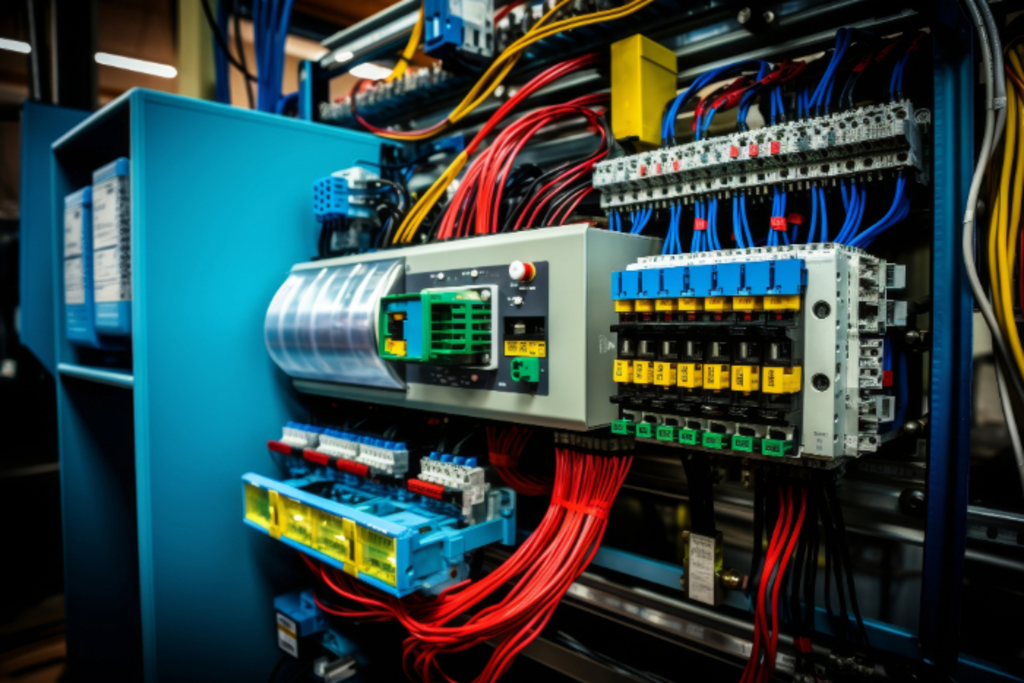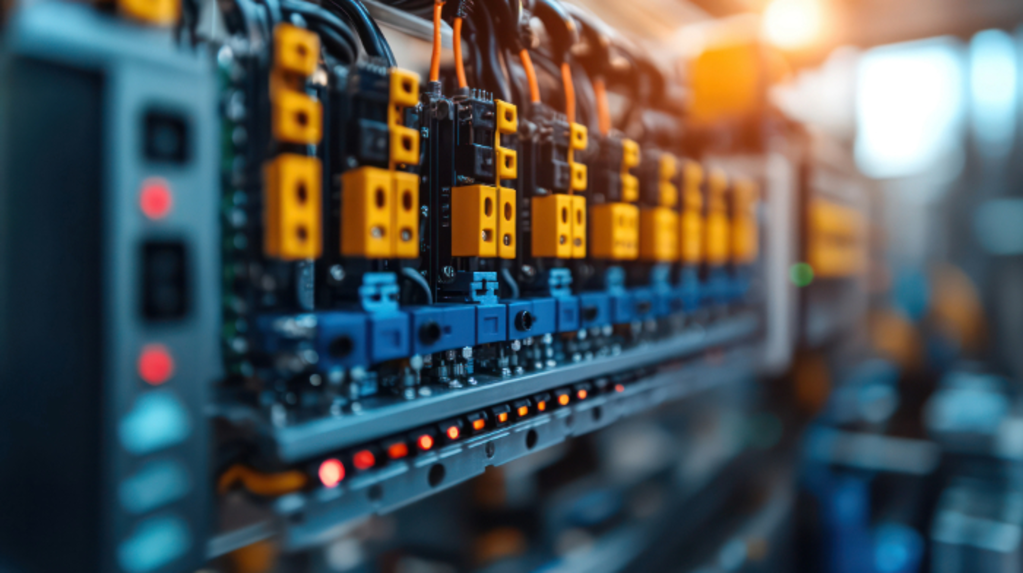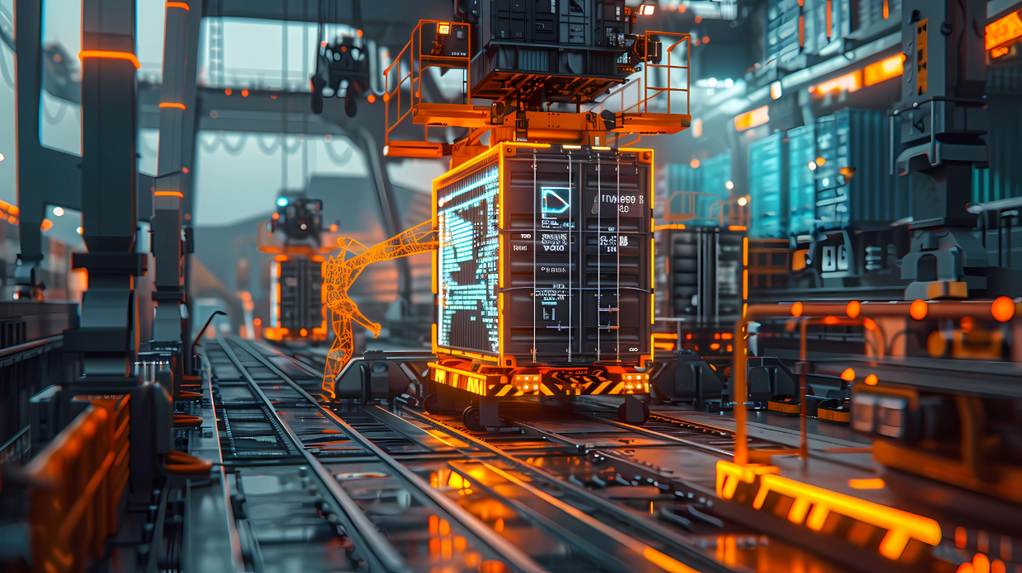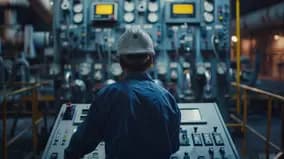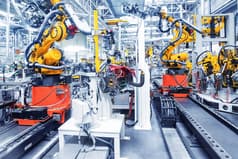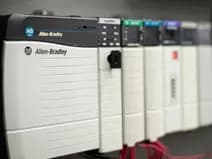Artificial intelligence has rapidly become a vital tool in modern industries, transforming how factories and plants operate worldwide. In the context of industrial automation, AI combines technologies like machine learning, computer vision, and predictive analytics to help companies make smarter, faster decisions. When integrated with systems such as PLCs, SCADA, robotics, and IoT devices, AI creates smarter production lines that adapt in real time to changing conditions. Companies across sectors now use artificial intelligence in industrial automation to boost productivity, cut costs, and maintain high-quality standards, setting the stage for the next generation of manufacturing.
Key Benefits of AI in Industrial Environments
Introducing artificial intelligence in manufacturing opens the door to significant advantages that help factories stay competitive. From predictive maintenance to optimized resource use, AI-powered systems can transform daily operations.
Improved Operational Efficiency
One of the biggest benefits of AI in manufacturing industry environments is higher operational efficiency. Machine learning in manufacturing systems analyzes massive amounts of production data to find hidden patterns and opportunities for improvement. For example, AI algorithms can adjust production schedules, balance workloads between machines, and identify bottlenecks before they impact output. These improvements help manufacturers increase throughput without major equipment upgrades.
Predictive Maintenance and Reduced Downtime
Unplanned downtime can cause huge financial losses, especially in industries with expensive equipment like metal manufacturing or oil and gas. AI-driven predictive maintenance uses real-time sensor data to monitor the health of machines. Instead of relying on routine maintenance schedules, AI predicts when parts are likely to fail and recommends repairs in advance. This approach keeps machines running longer, reduces costly breakdowns, and helps manufacturers plan maintenance during low-demand periods.
Enhanced Product Quality and Defect Detection
Maintaining consistent product quality is critical in sectors like food and beverages, and Consumer goods and packaging. AI-powered visual inspection systems detect defects that human eyes might miss. These systems use computer vision and deep learning models to check thousands of products per minute for flaws, improving accuracy and reducing waste. Generative AI in manufacturing also helps design better quality control models by simulating defects and training inspection systems on more data.
Energy and Resource Optimization
AI can also help companies manage energy use and raw materials more responsibly. For example, AI monitors energy consumption across entire facilities and adjusts operations to reduce unnecessary waste. In energy-intensive industries such as automotive and transportation, AI systems balance energy loads, optimize heating or cooling, and suggest ways to reduce carbon footprints, all while keeping production targets on track.
Common Use Cases and Applications
Artificial intelligence in industrial automation isn’t just a futuristic idea; it’s already here in the form of practical applications that solve real challenges.
AI-Powered Visual Inspection Systems
Visual inspection powered by AI is one of the most widespread use cases today. These systems use high-resolution cameras and computer vision algorithms to scan products for defects, misalignments, or contamination. For example, in food and beverages, AI checks packaged foods for correct labeling, fill levels, or seal integrity. This ensures only safe, high-quality products reach customers.
Intelligent Robotics for Assembly and Handling
Robots are standard in modern factories, but when combined with AI, they become far more flexible. AI allows robots to learn new tasks and adapt to slight variations in materials or positioning. In metal manufacturing, intelligent robotic arms can handle delicate parts, weld with precision, or adjust movements on the fly to avoid collisions. This makes production lines more adaptable to product changes and customization.
Predictive Analytics for Maintenance and Process Control
AI’s predictive analytics capabilities extend beyond maintenance. They monitor entire processes, spotting signs of inefficiency or wear before they affect production. For example, an AI model might detect vibration patterns in CNC machines that indicate early signs of tool wear, prompting operators to replace tools before defects occur. This proactive approach keeps quality high and production smooth.
Demand Forecasting and Inventory Management
Matching production with demand is vital for industries such as consumer goods and packaging or automotive and transportation. Machine learning in manufacturing predicts customer demand based on sales trends, seasonal factors, and supply chain data. This helps manufacturers adjust production schedules, optimize inventory, and avoid both shortages and overproduction, saving money and resources.
AI Applications Across Key Industries
BSP Automation supports a wide range of sectors, each with specific challenges that artificial intelligence helps address. As AI becomes more integrated with automation technologies, its impact across industries becomes clearer, improving quality, efficiency, safety, and responsiveness at every level.
Metal Manufacturing
Metal manufacturing depends on precision, uptime, and process consistency. Even small defects or downtime can lead to costly delays or rejected batches. AI tools make a significant difference by constantly monitoring both machinery and products.
- Predictive maintenance models analyze vibration, temperature, and acoustic signals from CNC machines, lathes, and presses. They detect early signs of wear or failure and help avoid production stoppages.
- AI-powered defect detection uses thermal imaging or computer vision to spot issues in casting, forging, or welding. These systems outperform traditional inspection and reduce reliance on manual checks.
By incorporating these AI solutions,
metal manufacturing operations increase both product quality and equipment lifespan, leading to more reliable output.
Food & Beverages
The food and beverage industry requires strict quality control and traceability. AI plays a growing role in helping producers meet health and safety standards while reducing waste and improving forecasting.
- Computer vision systems inspect packaging, labels, seals, and product shapes at high speed, ensuring every item meets hygiene and appearance standards.
- Smart packaging integrated with AI helps monitor freshness, track shipments, and manage inventory.
- Demand forecasting tools use historical sales, seasonality, and external trends to adjust batch sizes and reduce spoilage.
AI is especially useful for manufacturers producing short-shelf-life items, where real-time adjustments and fast inspections can significantly reduce loss. Learn more on our
Food and Beverages page.
Consumer Goods and Packaging
The
Consumer goods and packaging industry faces pressure to maintain quality while adapting to fast-changing customer demands. AI solutions help automate packaging lines, optimize logistics, and support rapid product changes.
- AI-driven robotics handles product sorting, carton filling, and labeling with minimal reconfiguration between batches.
- Generative AI in manufacturing is used to create improved packaging designs that minimize waste and lower material costs.
- Inventory optimization tools ensure that packaging supplies and finished goods stay at ideal levels, avoiding overstocking or delays.
This industry often operates at high speed and high volume, so AI’s ability to make data-driven decisions in real time helps companies reduce errors and maintain tight production schedules.
Oil and Gas
AI brings strong value to the
Oil and gas sector, where safety, asset management, and downtime reduction are top priorities. The environments are complex, and failures can be both dangerous and expensive.
- Pipeline monitoring systems powered by AI detect pressure changes, vibration anomalies, or leaks far faster than traditional SCADA systems.
- Autonomous drones and robots inspect offshore rigs, gas processing units, or pipelines in remote areas, gathering real-time visual and sensor data without putting humans at risk.
- Predictive analytics identifies corrosion risks, equipment degradation, or operational inefficiencies before they become serious issues.
By combining these technologies, companies improve compliance, reduce environmental hazards, and maintain better control over distributed assets.
Automotive and Transportation
The automotive sector has always been at the forefront of industrial automation. Now, AI is pushing this innovation further, improving production quality, logistics, and traceability.
- Robot-assisted assembly enhanced with AI can adjust its grip, angle, or tool speed based on small variations in components, increasing consistency on the line.
- AI-powered visual inspections detect paint defects, alignment errors, or faulty welds in real time.
- Supply chain optimization tools use AI to predict parts shortages, optimize routes, and adapt to unexpected delays.
Companies in the
Automotive and transportation industries are also starting to use AI to simulate production workflows, helping teams test process changes virtually before making adjustments on the floor.
Challenges and Considerations in Adopting AI
Despite its clear advantages, adopting artificial intelligence in industrial automation comes with challenges. Many manufacturers rely on older equipment and legacy systems that weren’t built to handle AI. Integrating new AI tools with existing machines and software can be complex and costly.
High-quality, reliable data is another hurdle. AI models need huge amounts of accurate data to learn and deliver results. Poor or incomplete data can lead to wrong predictions or flawed automation.
Workforce readiness is also important. Employees must understand how to work with AI systems, interpret insights, and handle new technologies. This often requires training and upskilling, which takes time and investment.
Cybersecurity is a growing concern too. AI systems process sensitive operational data, so companies must protect this information against cyber threats.
Finally, companies must navigate ethical and regulatory questions. They must ensure that AI decisions are transparent and don’t unintentionally introduce bias or safety risks.
The Future of AI in Industrial Automation
Artificial intelligence in industrial automation continues to evolve rapidly. One trend to watch is edge AI, which processes data close to the source rather than sending it all to the cloud. This reduces latency and keeps production lines responsive in real time.
Another emerging area is AI-powered digital twins, virtual replicas of physical machines that simulate performance, test changes, and predict failures before they happen.
Generative AI in manufacturing is also gaining traction. By simulating countless design possibilities, generative AI helps engineers develop better parts or more efficient production layouts.
Finally, human-AI collaboration will shape the next phase of automation. Instead of replacing workers, AI will assist them, making tasks safer, faster, and more accurate.
As these trends grow, companies that invest early will stay ahead. Partnering with a
trusted industrial parts supplier ensures that automation systems, PLCs, and connected devices can support advanced AI tools for years to come. Working with suppliers of
world’s leading PLC brands allows businesses to access proven technologies that are both reliable and future-ready.
Conclusion
Artificial intelligence in industrial automation is more than just a tech trend, it’s transforming how factories operate worldwide. From predictive maintenance and visual inspections to supply chain optimization and smart robotics, AI empowers manufacturers to work smarter and deliver consistent results.
Adopting AI comes with challenges, but the rewards far outweigh the obstacles for companies ready to adapt. At BSP Automation, we help businesses across
industries unlock the potential of AI by supplying reliable, compatible parts and systems. Whether you work in Metal manufacturing, Food and beverages, Consumer goods and packaging, Oil and gas, or Automotive and transportation, we’re here to help your operation move forward with confidence.


